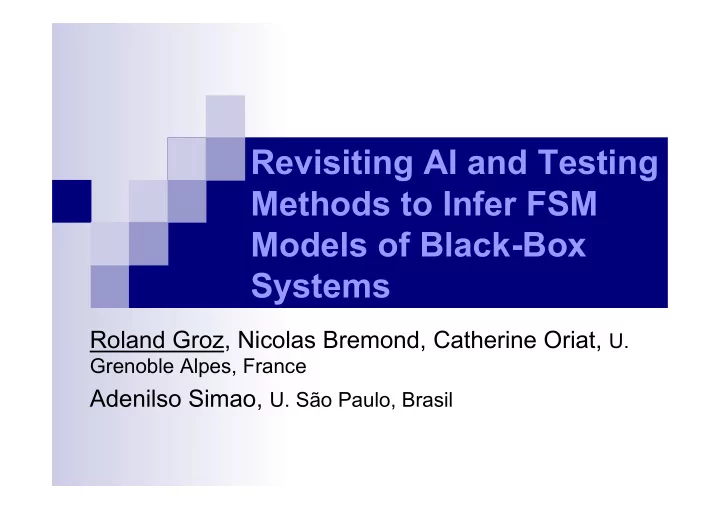

Revisiting AI and Testing Methods to Infer FSM Models of Black-Box Systems Roland Groz, Nicolas Bremond, Catherine Oriat, U. Grenoble Alpes, France Adenilso Simao, U. São Paulo, Brasil
Global context: inferring models thru testing n Model-based testing is good (systematic) n But often NO model available n Goal: keep benefits of MBT when no model Method: Testing a system is LEARNING the behaviour of a system è Use “ML” techniques to learn model Problem: learn correct & “complete” behaviour of Black Box systems that cannot be reset 2
Motivational example • Reverse-engineer models of Web applications to detect security vulnerabilities using Learning algos (e.g. L*) • E-Health app provided by Siemens as a Virtual Machine Learner • single I/O RTT over LAN: < 1 ms • reset=reboot VM: ~1 minute • Timewise: reset is O(10 5 ) RTT in example • Many systems CANNOT be reset AT ALL. 3
Key difficulties when no reset n How can we know in which state seq is applied ? n No backtrack possible to check other sequence n Losing track: we no longer know from where we apply an input 4
Existing algorithms without reset n Rivest & Schapire 1993 ¨ Homing sequence : ersatz for resetting in one of several states ¨ Then use a copy of L* for each homed state n LocW (Groz & al. 2015) ¨ Assume W-set known (identifying sequences) ¨ Localize in an identifiable state with nested W n Constraint-solving (Petrenko & al. 2017) ¨ Assume bound n on #states. n NEW (this paper): hW inference ¨ No assumption ! Discovers h(oming) and W (characterizing) 5
Results on random machines (log-log) relationship between length of trace and number of state 1x10 7 length of trace (symbols) 1x10 6 100000 10000 1000 hW Rivest and Schapire 100 Constraints solver LocW 10 10 100 1000 number of states 6
b / 1 Homing seq and W-sets 3 a / 0 b / 1 a / 0 a / 1 n h=a is homing sequence: 1 2 b / 0 ¨ After a/0 or a/1, final state=2, (in this case h is a reset because single final state) n W={a,b} is a characterizing set ¨ a/1, b/1 : characterize state 1 ¨ a/0, b/0 : characterize state 2 ¨ a/0, b/1 : characterize state 3 Note: single homing sequence, but most machines require |W|> 1 7
b / 1 hW inference: core loop for 3 a / 0 b / 1 a / 0 h=a W={a, b} a / 1 1 2 n Repeatedly apply h, an input and w k b / 0 to progressively learn transitions ¨ More generally h α xw k , α transfer seq., x input n h/1.w 1 /0 h/0. w 1 /0 h/0. w 2 /0 ¨ At this point we know that tail state of h/0 is state characterized by {a/0,b/0} (and we are now in state 1) n h/1: we are again in tail state h/1, apply w 2 n b/0: now we know tail state h/1 is {a/0,b/0} 8
b / 1 hW inference: cont’d 3 a / 0 b / 1 a / 0 h=a W={a, b} a / 1 1 2 n Known b / 0 ¨ h/0 -> {a/0,b/0} ¨ h/1 -> {a/0,b/0} n (and we are in 1). Apply h: a/1. We are now in a known state {a/0,b/0} n So we learn a transition from it: ¨ a/0 so we know the output on a is 0 a / 0 a / 0 ¨ And tail state answers w 1 /0. { a0,b0} 9
b / 1 hW inference: cont’d 3 a / 0 b / 1 a / 0 h=a W={a, b} a / 1 1 2 n Known b / 0 ¨ h/0 -> {a/0,b/0} ; h/1 -> {a/0,b/0} a / 0 a / 0 ¨ Partial transition { a0,b0} n We reapply h/0. So now we can complete b / 0 knowledge of transition: a/0 b/0 n So we have completely learnt transition a / 0 n Going on, we learn the full FSM { a0,b0} 10
Learning with unknown h, W Key idea: use putative h, W n Start with any (incorrect) h and W ¨ E.g. empty sequence and set ¨ Different states will be confused (merged) ¨ So this will lead to apparent NonDeterminism (ND) n ND: reapplying a transition x/0, we see x/1 ¨ Depending on context, we can either extend h to hx or W to W ∪ {x} n Progressively extending h and W until they are homing & characterizing for the BB 11
Does it work ? n Yes ! ¨ Naive, but turns out to converge fast n Actually, enhanced with a number of heuristics not detailed here ¨ Outperforms previous algorithms n And even algorithms with reset, such as L* ¨ No initial knowledge needed (apart input set) ¨ Still needs an oracle to check equivalence in the end (or get counterexample to refine) n Oracle can just be random walk 12
Recommend
More recommend